Prediction of Thermal Response of Burning Outdoor Vegetation Using UAS-Based Remote Sensing and Artificial Intelligence
Abstract
Highlights
- Developed a UAS-based framework to identify and delineate Lilly Pilly vegetation using ML, watershed, and point cloud delineation tool.
- Built a predictive model estimating simulation-based Lilly Pilly vegetation thermal responses with >99% validation accuracy.
- Demonstrate a scalable method to assess wildfire risk near residential areas.
- Extendable to multiple species, varied vegetation shapes, and higher-altitude UAS imagery.
Abstract
1. Introduction
- Lilly Pilly semantic segmentation: This focuses on the segmentation of Lilly Pilly, using MS imagery captured by UAS. Training data was manually labeled from imagery collected at a large nursery site [38], and a stacked ensemble learning (EL) approach was employed to train the semantic segmentation model. The model’s performance was evaluated using standard metrics to assess its predictive accuracy and segmentation quality.
- Thermal response prediction: This is developed to estimate the maximum T and HF that would result if the segmented vegetation were to ignite. Structural parameters were extracted from LiDAR point clouds to generate synthetic data of Lilly Pilly geometries across a range of sizes. The thermal responses of the Lilly Pilly were derived from Simultaneous Thermal Analyzer (STA) tests and incorporated into the simulation. The synthetic vegetation models were voxelized and used in Fire Dynamic Simulator (FDS) to simulate and determine the maximum values of thermal responses at varying distances using a grid of T and HF sensors. To address the high computational cost and scenario-specific setup of physics-based fire simulations, we employ a data-driven model that enables rapid thermal response prediction without the burden of full CFD computations.
2. Materials and Methods
2.1. Experimental Design
2.2. Study Site
2.3. Data Acquisition
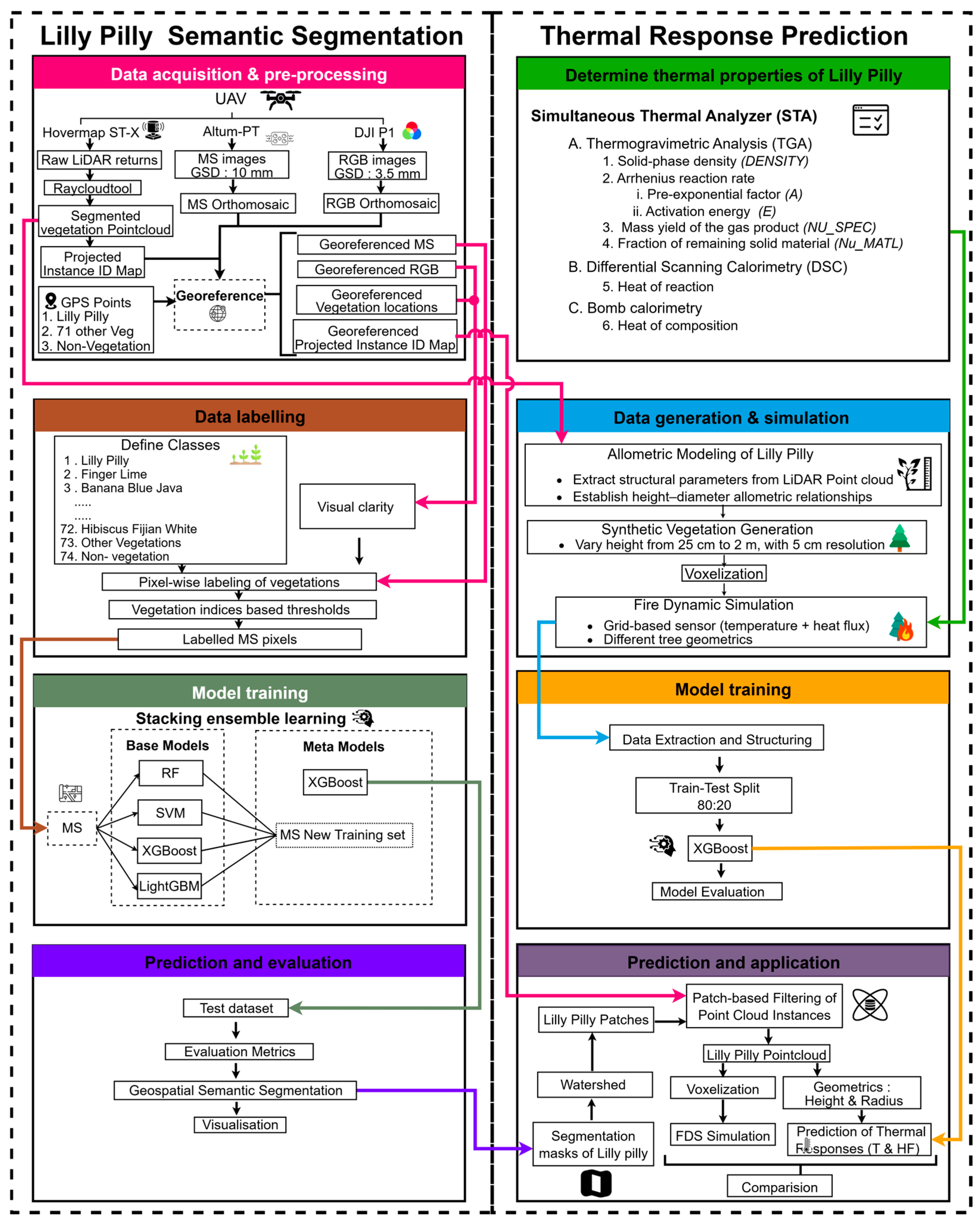
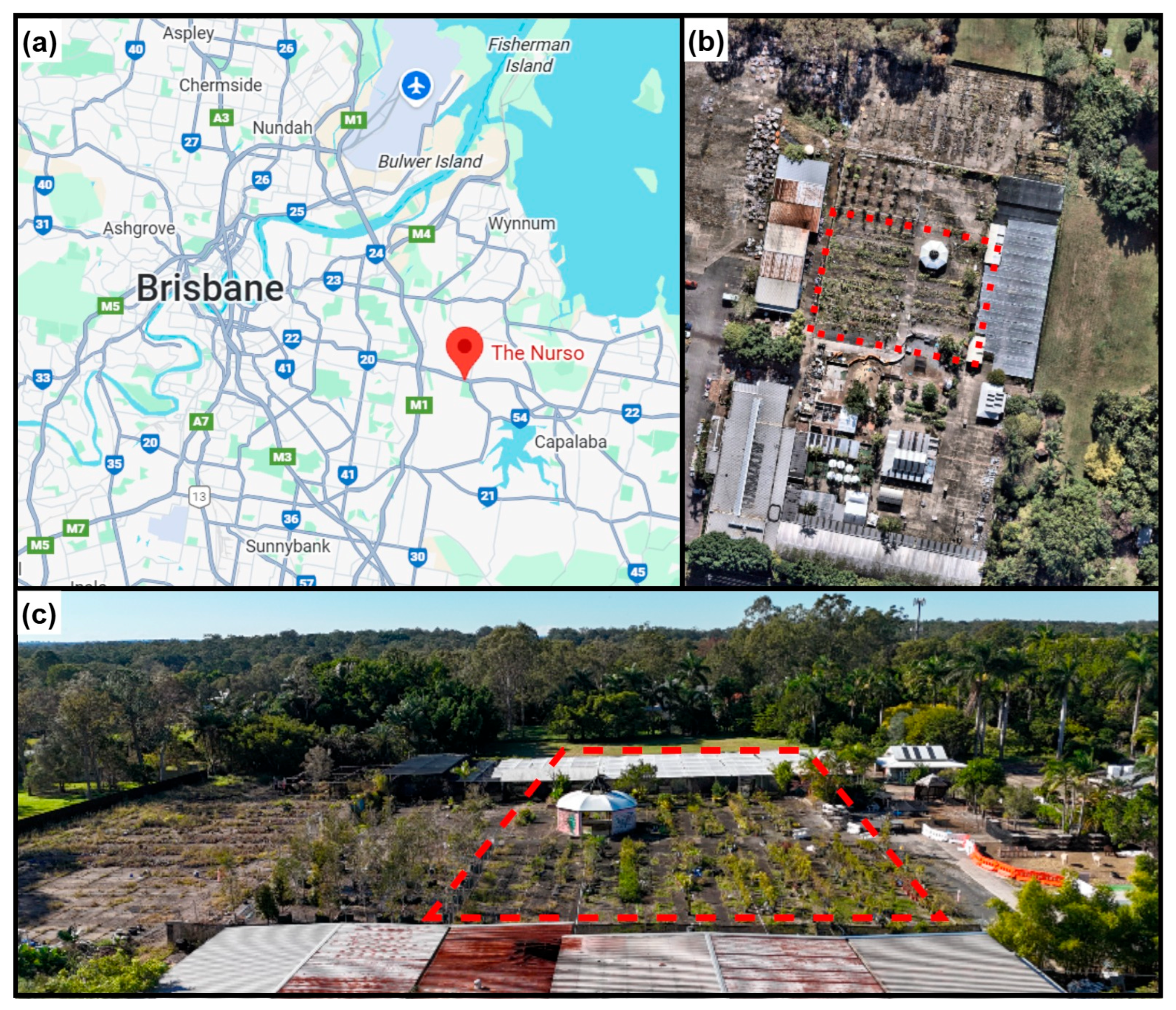
2.4. Individual Vegetation Delineation in 3D Point Clouds and Instance ID Map Generation
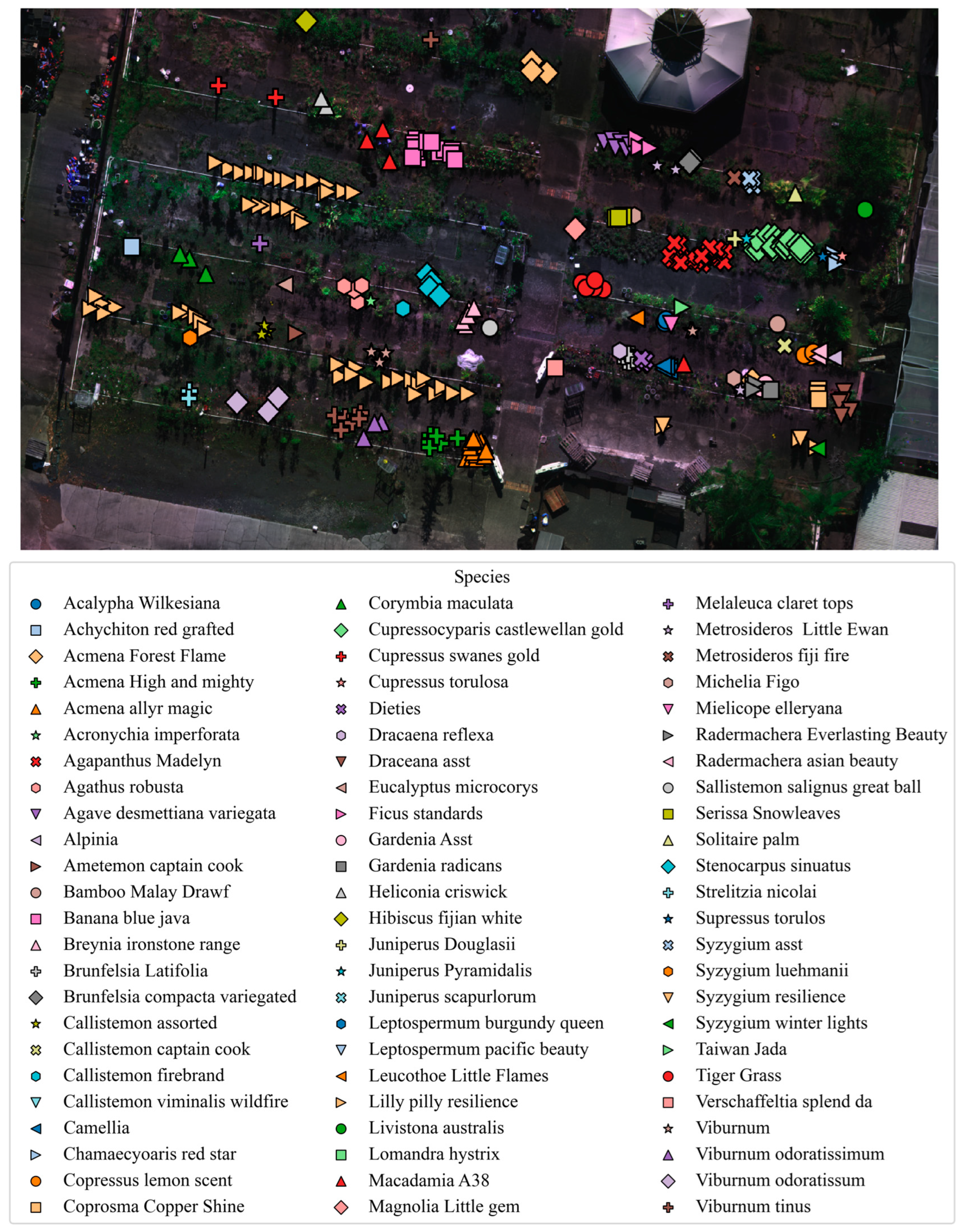
2.5. Lilly Pilly Semantic Segmentation
2.5.1. Pixel Wise Labeling
2.5.2. Ensemble Learning (EL)
2.5.3. Generation of Lilly Pilly Patches
2.6. Development of Thermal Response Prediction Model
2.6.1. Determination of Thermal Properties of Lilly Pilly
2.6.2. Data Generation and Simulation
2.6.3. Thermal Response Prediction Model Training
2.6.4. Thermal Response Prediction and Application
3. Results
3.1. Lilly Pilly Semantic Segmentation Performance
3.2. Instance-Based Vegetation Segmentation and Filtering Lilly Pilly
3.3. Thermal Response Prediction
3.4. Comparison of Predicted Thermal Response
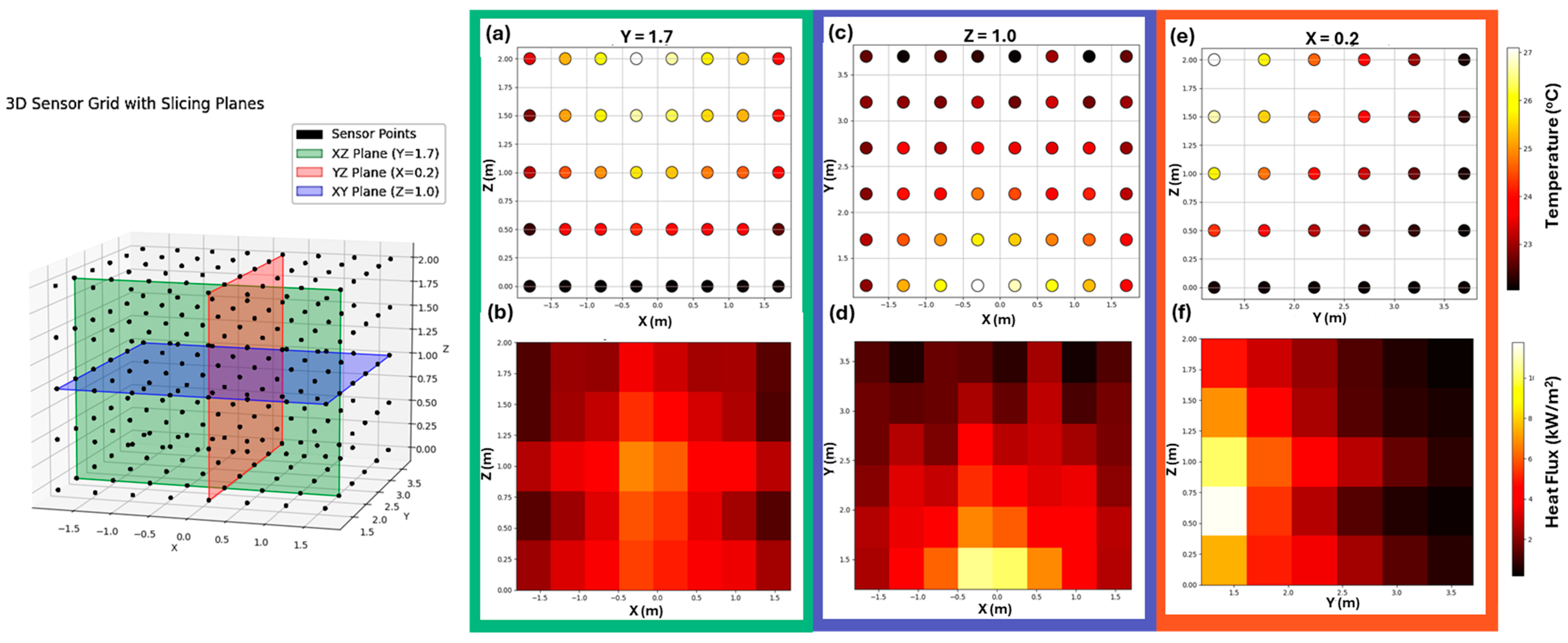
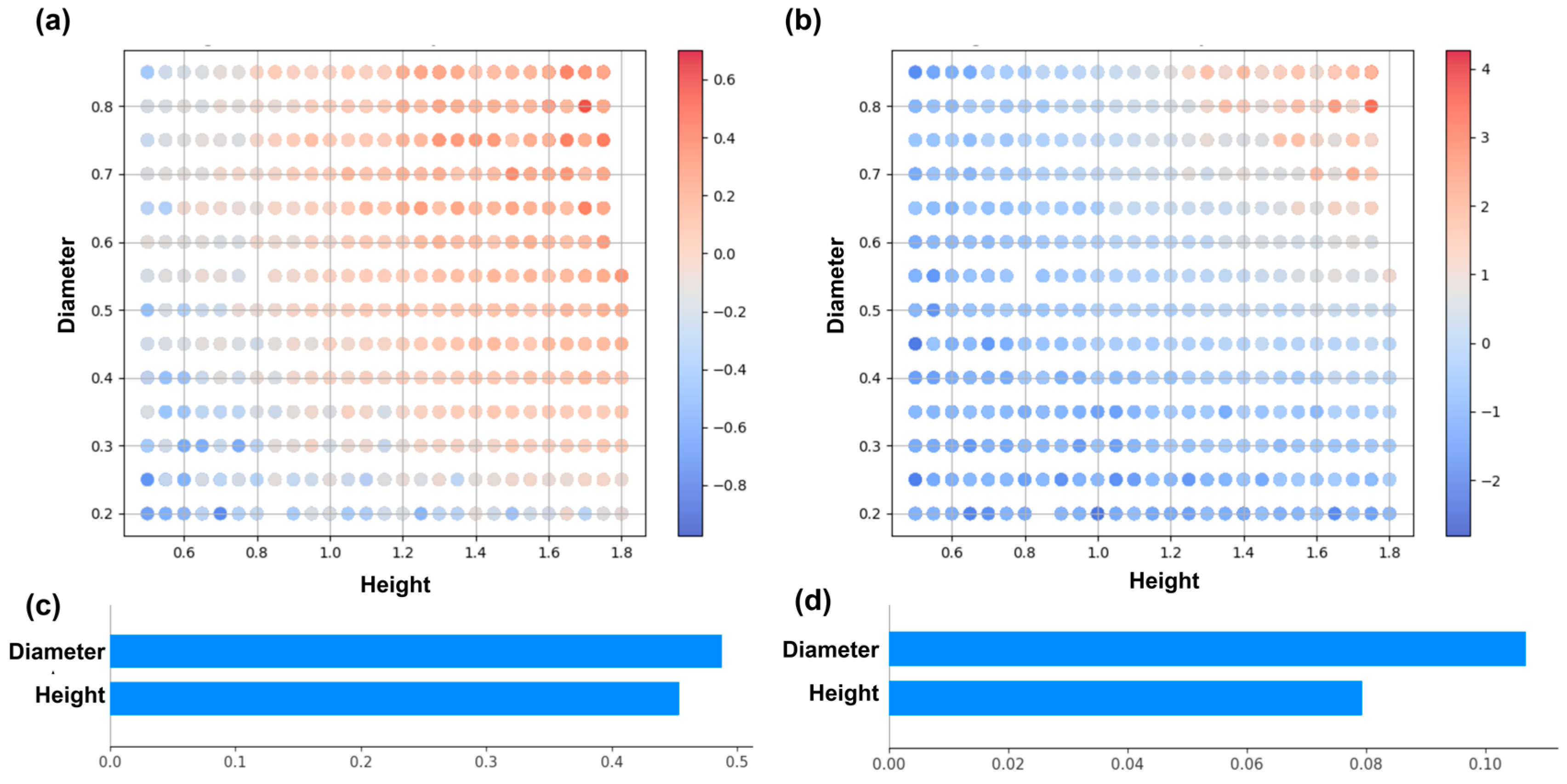
| Tree ID | RMSE | |
|---|---|---|
| T | HF | |
| 1 | 0.4916 | 0.4996 |
| 2 | 0.1894 | 0.3055 |
| 3 | 0.5452 | 1.2341 |
| 4 | 0.2435 | 0.3384 |
| 5 | 0.1894 | 0.3055 |
| 6 | 0.2202 | 0.3206 |
| 7 | 0.567 | 0.9070 |
| 8 | 0.533 | 0.4624 |
| 9 | 0.1904 | 0.3389 |
| 10 | 0.533 | 0.4624 |
| 11 | 0.4358 | 0.7644 |
| 12 | 0.1811 | 0.390 |
| 13 | 0.2482 | 0.5056 |
| 14 | 0.4959 | 0.7410 |
| 15 | 0.1894 | 0.3055 |
| 16 | 0.1784 | 0.5190 |
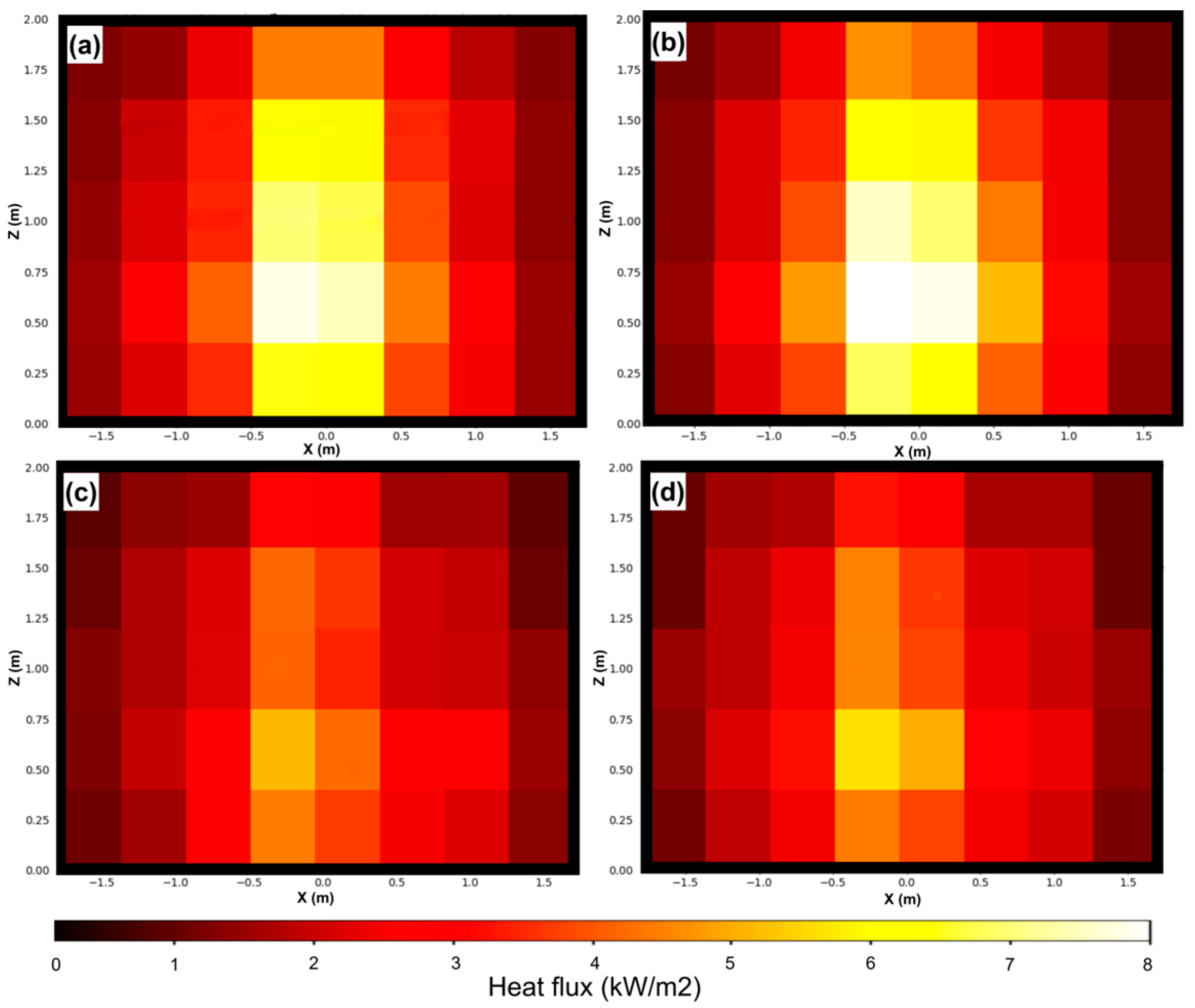

4. Discussion
5. Limitations and Future Work
6. Conclusions
- The framework was validated based on the assumption that Lilly Pilly is pruned into a cone shape, whereas real Lilly Pilly vegetation can be maintained in varied geometries, such as rectangular or trapezoidal prisms.
- The study was applied only to Lilly Pilly, and the lack of thermal property data limits adaptation to other species.
- Vegetation semantic segmentation relies on high-resolution imagery and using different sensors or higher-altitude imagery may affect the segmentation performance.
Author Contributions
Funding
Data Availability Statement
Acknowledgments
Conflicts of Interest
References
- Moritz, M.; Batllori, E.; Bradstock, R.A.; Gill, A.M.; Handmer, J.; Hessburg, P.F.; Leonard, J.; McCaffrey, S.; Odion, D.C.; Schoennagel, T.; et al. Learning to coexist with wildfire. Nature 2014, 515, 58–66. [Google Scholar] [CrossRef] [PubMed]
- Westerling, A. Increasing western US forest wildfire activity: Sensitivity to changes in the timing of spring. Philos. Trans. R. Soc. B Biol. Sci. 2016, 371, 20150178. [Google Scholar] [CrossRef]
- Ottmar, R.D. Wildland fire emissions, carbon, and climate: Modeling fuel consumption. For. Ecol. Manag. 2014, 317, 41–50. [Google Scholar] [CrossRef]
- Bradstock, R.A. A biogeographic model of fire regimes in Australia: Current and future implications. Glob. Ecol. Biogeogr. 2010, 19, 145–158. [Google Scholar] [CrossRef]
- Baker, W.L.; Mladenoff, D.J. Progress and future directions in spatial modeling of forest landscapes. In Spatial Modeling of Forest Landscape Change; Cambridge University Press: Cambridge, UK, 1999; pp. 333–349. [Google Scholar]
- Cohen, J.D. Preventing disaster: Home ignitability in the wildland-urban interface. J. For. 2000, 98, 15–21. [Google Scholar] [CrossRef]
- Mell, W.; Maranghides, A.; McDermott, R.; Manzello, S.L. Numerical simulation and experiments of burning douglas fir trees. Combust. Flame 2009, 156, 2023–2041. [Google Scholar] [CrossRef]
- Benedict, K.B.; Lee, J.E.; Kumar, N.; Badal, P.S.; Barbato, M.; Dubey, M.K.; Aiken, A.C. Wildland Urban Interface (WUI) Emissions: Laboratory Measurement of Aerosol and Trace Gas from Combustion of Manufactured Building Materials. ACS ES&T Air 2024, 1, 1673–1686. [Google Scholar] [CrossRef]
- Zhou, A. Performance evaluation of ignition-resistant materials for structure fire protection in the WUI. In Proceedings of the 13th International Conference and Exhibition on Fire and Materials (Fire and Materials 2013), San Francisco, CA, USA, 28–30 January 2013; pp. 355–366. [Google Scholar]
- Caton, S.E.; Hakes, R.S.P.; Gorham, D.J.; Zhou, A.; Gollner, M.J. Review of Pathways for Building Fire Spread in the Wildland Urban Interface Part I: Exposure Conditions. Fire Technol. 2017, 53, 429–473. [Google Scholar] [CrossRef]
- Intini, P.; Ronchi, E.; Gwynne, S.; Bénichou, N. Guidance on Design and Construction of the Built Environment Against Wildland Urban Interface Fire Hazard: A Review. Fire Technol. 2020, 56, 1853–1883. [Google Scholar] [CrossRef]
- Finney, M.A. FARSITE, Fire Area Simulator—Model Development and Evaluation; U.S. Department of Agriculture, Forest Service, Rocky Mountain Research Station: Ogden, UT, USA, 1998. [Google Scholar]
- Salis, M. Fire Behaviour Simulation in Mediterranean Maquis Using FARSITE (Fire Area Simulator). Ph.D. Thesis, University of Sassari, Sardinia, Italy, 2008. [Google Scholar]
- Andrews, P.L.; Bevins, C.D.; Seli, R.C. BehavePlus Fire Modeling System, Version 4.0: User’s Guide; General Technical Report, RMRS-GTR-106 Revised; Department of Agriculture, Forest Service, Rocky Mountain Research Station: Ogden, UT, USA, 2005; Volume 106, 132p. [Google Scholar]
- Tolhurst, K.; Shields, B.; Chong, D. Phoenix: Development and application of a bushfire risk management tool. Aust. J. Emerg. Manag. 2008, 23, 47–54. [Google Scholar]
- Salamí, E.; Barrado, C.; Pastor, E. UAV Flight Experiments Applied to the Remote Sensing of Vegetated Areas. Remote Sens. 2014, 6, 11051–11081. [Google Scholar] [CrossRef]
- Huot, F.; Hu, R.L.; Goyal, N.; Sankar, T.; Ihme, M.; Chen, Y.F. Next Day Wildfire Spread: A Machine Learning Dataset to Predict Wildfire Spreading From Remote-Sensing Data. IEEE Trans. Geosci. Remote Sens. 2022, 60, 4412513. [Google Scholar] [CrossRef]
- Camps-Valls, G.; Tuia, D.; Bruzzone, L.; Benediktsson, J.A. Advances in Hyperspectral Image Classification: Earth Monitoring with Statistical Learning Methods. IEEE Signal Process. Mag. 2014, 31, 45–54. [Google Scholar] [CrossRef]
- Kanand, T.; Kemper, G.; König, R.; Kemper, H. Wildfire Detection and Disaster Monitoring System Using UAS and Sensor Fusion Technologies. Int. Arch. Photogramm. Remote Sens. Spat. Inf. Sci. 2020, 43, 1671–1675. [Google Scholar] [CrossRef]
- Ganteaume, A.; Guillaume, B.; Girardin, B.; Guerra, F. CFD modelling of WUI fire behaviour in historical fire cases according to different fuel management scenarios. Int. J. Wildland Fire 2023, 32, 363–379. [Google Scholar] [CrossRef]
- Mell, W.; Jenkins, M.A.; Gould, J.; Cheney, P. A physics-based approach to modelling grassland fires. Int. J. Wildland Fire 2007, 16, 1–22. [Google Scholar] [CrossRef]
- Anderson, W.R.; Cruz, M.G.; Fernandes, P.M.; McCaw, L.; Vega, J.A.; Bradstock, R.A.; Fogarty, L.; Gould, J.; McCarthy, G.; Marsden-Smedley, J.B.; et al. A generic, empirical-based model for predicting rate of fire spread in shrublands. Int. J. Wildland Fire 2015, 24, 443–460. [Google Scholar] [CrossRef]
- Fiorini, C.; Craveiro, H.D.; Santiago, A.; Laím, L.; Simões da Silva, L. Parametric evaluation of heat transfer mechanisms in a WUI fire scenario. Int. J. Wildland Fire 2023, 32, 1600–1618. [Google Scholar] [CrossRef]
- Keerthinathan, P.; Winsen, M.; Krishnakumar, T.; Ariyanayagam, A.; Hamilton, G.; Gonzalez, F. Modelling LiDAR-Based Vegetation Geometry for Computational Fluid Dynamics Heat Transfer Models. Remote Sens. 2025, 17, 552. [Google Scholar] [CrossRef]
- Hendawitharana, S.; Ariyanayagam, A.; Mahendran, M.; Gonzalez, F. LiDAR-based Computational Fluid Dynamics heat transfer models for bushfire conditions. Int. J. Disaster Risk Reduct. 2021, 66, 102587. [Google Scholar] [CrossRef]
- Rocha, K.D.; Silva, C.A.; Cosenza, D.N.; Mohan, M.; Klauberg, C.; Schlickmann, M.B.; Xia, J.; Leite, R.V.; de Almeida, D.R.A.; Atkins, J.W.; et al. Crown-Level Structure and Fuel Load Characterization from Airborne and Terrestrial Laser Scanning in a Longleaf Pine (Pinus palustris Mill.) Forest Ecosystem. Remote Sens. 2023, 15, 1002. [Google Scholar] [CrossRef]
- Sakellariou, S.; Sfougaris, A.; Christopoulou, O.; Tampekis, S. Integrated wildfire risk assessment of natural and anthropogenic ecosystems based on simulation modeling and remotely sensed data fusion. Int. J. Disaster Risk Reduct. 2022, 78, 103129. [Google Scholar] [CrossRef]
- Murray, A.T.; Baik, J.; Figueroa, V.E.; Rini, D.; Moritz, M.A.; Roberts, D.A.; Sweeney, S.H.; Carvalho, L.M.; Jones, C. Developing effective wildfire risk mitigation plans for the wildland urban interface. Int. J. Appl. Earth Obs. Geoinf. 2023, 124, 103531. [Google Scholar] [CrossRef]
- Sharma, S.K.; Aryal, J.; Rajabifard, A. Remote sensing and meteorological data fusion in predicting bushfire severity: A case study from Victoria, Australia. Remote Sens. 2022, 14, 1645. [Google Scholar] [CrossRef]
- Gong, A.; Huang, Z.; Liu, L.; Yang, Y.; Ba, W.; Wang, H. Development of an Index for Forest Fire Risk Assessment Considering Hazard Factors and the Hazard-Formative Environment. Remote Sens. 2023, 15, 5077. [Google Scholar] [CrossRef]
- Keerthinathan, P.; Amarasingam, N.; Kelly, J.E.; Mandel, N.; Dehaan, R.L.; Zheng, L.; Hamilton, G.; Gonzalez, F. African Lovegrass Segmentation with Artificial Intelligence Using UAS-Based Multispectral and Hyperspectral Imagery. Remote Sens. 2024, 16, 2363. [Google Scholar] [CrossRef]
- Amarasingam, N.; Kelly, J.E.; Mandel, N.; Crabbe, R.; Sandino, J.; Wheeler, D.; Zheng, L.; Keerthinathan, P.; Cherry, H.; Hamilton, M.; et al. Opportunities and limitations of new remote sensing and AI technologies for weed detection and mapping—Guidelines and a new community of practice. In Proceedings of the 23rd Australasian Weeds Conference: Breaking the Cycle—Towards Sustainable Weed Management, Brisbane, Australia, 25–29 August 2024; Council of Australasian Weed Societies and Invasive Species Queensland: Brisbane, Australia, 2024; pp. 48–52. [Google Scholar]
- Chang, B.; Li, F.; Hu, Y.; Yin, H.; Feng, Z.; Zhao, L. Application of UAV remote sensing for vegetation identification: A review and meta-analysis. Front. Plant Sci. 2025, 16, 1452053. [Google Scholar] [CrossRef]
- Keerthinathan, P.; Amarasingam, N.; Hamilton, G.; Gonzalez, F. Exploring unmanned aerial systems operations in wildfire management: Data types, processing algorithms and navigation. Int. J. Remote Sens. 2023, 44, 5628–5685. [Google Scholar] [CrossRef]
- Yuan, C.; Liu, Z.; Zhang, Y. Fire detection using infrared images for UAV-based forest fire surveillance. In Proceedings of the 2017 International Conference on Unmanned Aircraft Systems (ICUAS), Miami, FL, USA, 13–16 June 2017; pp. 567–572. [Google Scholar] [CrossRef]
- Liu, X.; Zheng, C.; Wang, G.; Zhao, F.; Tian, Y.; Li, H. Integrating Multi-Source Remote Sensing Data for Forest Fire Risk Assessment. Forests 2024, 15, 2028. [Google Scholar] [CrossRef]
- Hird, A. A Guide to the Different Lilly Pilly Varieties in Australia. Ultimate Backyard. Available online: https://ultimatebackyard.com.au/lilly-pilly-varieties/ (accessed on 10 June 2025).
- The Nurso. Available online: https://www.thenurso.au/ (accessed on 20 May 2025).
- Topographic-Map. Chandler Topographic Map. Available online: https://en-au.topographic-map.com/map-z9gf3q/Chandler/?utm_source=chatgpt.com (accessed on 25 July 2025).
- Lowe, T.D.; Stepanas, K. RayCloudTools: A Concise Interface for Analysis and Manipulation of Ray Clouds. IEEE Access 2021, 9, 79712–79724. [Google Scholar] [CrossRef]
- Zhou, Z.-H. Ensemble Methods: Foundations and Algorithms; CRC Press: Boca Raton, FL, USA, 2025. [Google Scholar]
- Breiman, L. Random forests. Mach. Learn. 2001, 45, 5–32. [Google Scholar] [CrossRef]
- Cortes, C.; Vapnik, V.V. Support-Vector Networks. Mach. Learn. 1995, 20, 279–297. [Google Scholar] [CrossRef]
- Chen, T.; Guestrin, C. Xgboost: A scalable tree boosting system. In Proceedings of the 22nd ACM SIGKDD International Conference on Knowledge Discovery and Data Mining, San Francisco, CA, USA, 13–17 August 2016; pp. 785–794. [Google Scholar]
- Ke, G.; Meng, Q.; Finley, T.; Wang, T.; Chen, W.; Ma, W.; Ye, Q.; Liu, T.-Y. Lightgbm: A highly efficient gradient boosting decision tree. In Advances in Neural Information Processing Systems 30 (NIPS 2017); NIPS Foundation: San Diego, CA, USA, 2017; Volume 30. [Google Scholar]
- Wolpert, D.H. Stacked generalization. Neural Netw. 1992, 5, 241–259. [Google Scholar] [CrossRef]
- Pereira, M.B.; dos Santos, J.A. Chessmix: Spatial context data augmentation for remote sensing semantic segmentation. In Proceedings of the 2021 34th SIBGRAPI Conference on Graphics, Patterns and Images (SIBGRAPI), Gramado, Brazil, 18–22 October 2021; pp. 278–285. [Google Scholar]
- Vincent, L.; Soille, P. Watersheds in digital spaces: An efficient algorithm based on immersion simulations. IEEE Trans. Pattern Anal. Mach. Intell. 1991, 13, 583–598. [Google Scholar] [CrossRef]
- Meyer, F.; Beucher, S. Morphological segmentation. J. Vis. Commun. Image Represent 1990, 1, 21–46. [Google Scholar] [CrossRef]
- Xu, Y.; Mo, T.; Feng, Q.; Zhong, P.; Lai, M.; Chang, E.I.-C. Deep learning of feature representation with multiple instance learning for medical image analysis. In Proceedings of the 2014 IEEE International Conference on Acoustics, Speech and Signal Processing (ICASSP), Florence, Italy, 4–9 May 2014; pp. 1626–1630. [Google Scholar]
- Raymond, C.J. Investigation of Spontaneous Combustion Inhibition of Coal Fires Utilizing Differential Scanning Calorimetry and Thermogravimetric Analysis. Master’s Thesis, Kennesaw State University, Kennesaw, GA, USA, 2015. [Google Scholar]
- McGrattan, K.; Hostikka, S.; McDermott, R.; Floyd, J.; Weinschenk, C.; Overholt, K. Fire dynamics simulator user’s guide. NIST Spec. Publ. 2013, 1019, 1–339. [Google Scholar]
- McGrattan, K.; Hostikka, S.; McDermott, R.; Floyd, J.; Weinschenk, C.; Overholt, K. Fire dynamics simulator technical reference guide volume 1: Mathematical model. NIST Spec. Publ. 2013, 1018, 175. [Google Scholar]
- Nolan, R.H.; de Dios, V.R.; Boer, M.M.; Caccamo, G.; Goulden, M.L.; Bradstock, R.A. Predicting dead fine fuel moisture at regional scales using vapour pressure deficit from MODIS and gridded weather data. Remote Sens. Environ. 2016, 174, 100–108. [Google Scholar] [CrossRef]
- Modarres, M. Experimental and Numerical Analysis of Fire Behaviour in Typical Fuels at the Wildland-Urban Interface. Ph.D. Thesis, Universidade de Coimbra, Coimbra, Portugal, 2025. [Google Scholar]
- Wotton, B.M.; Gould, J.S.; McCaw, W.L.; Cheney, N.P.; Taylor, S.W. Flame temperature and residence time of fires in dry eucalypt forest. Int. J. Wildland Fire 2012, 21, 270–281. [Google Scholar] [CrossRef]
- Géron, A. Hands-On Machine Learning with Scikit-Learn, Keras, and TensorFlow; O’Reilly Media, Inc.: Sebastopol, CA, USA, 2022. [Google Scholar]
- Lundberg, S.M.; Lee, S.-I. A unified approach to interpreting model predictions. In Advances in Neural Information Processing Systems 30 (NIPS 2017); NIPS Foundation: San Diego, CA, USA, 2017; Volume 30. [Google Scholar]
- Balestra, M.; Marselis, S.; Sankey, T.T.; Cabo, C.; Liang, X.; Mokroš, M.; Peng, X.; Singh, A.; Stereńczak, K.; Vega, C.; et al. LiDAR Data Fusion to Improve Forest Attribute Estimates: A Review. Curr. For. Rep. 2024, 10, 281–297. [Google Scholar] [CrossRef]
- Balestra, M.; Tonelli, E.; Vitali, A.; Urbinati, C.; Frontoni, E.; Pierdicca, R. Geomatic Data Fusion for 3D Tree Modeling: The Case Study of Monumental Chestnut Trees. Remote Sens. 2023, 15, 2197. [Google Scholar] [CrossRef]
- Sankey, T.; Donager, J.; McVay, J.; Sankey, J.B. UAV lidar and hyperspectral fusion for forest monitoring in the southwestern USA. Remote Sens. Environ. 2017, 195, 30–43. [Google Scholar] [CrossRef]
- Norton, C.L.; Hartfield, K.; Collins, C.D.H.; van Leeuwen, W.J.D.; Metz, L.J. Multi-Temporal LiDAR and Hyperspectral Data Fusion for Classification of Semi-Arid Woody Cover Species. Remote Sens. 2022, 14, 2896. [Google Scholar] [CrossRef]
- Hall, E.C.; Lara, M.J. Multisensor UAS mapping of Plant Species and Plant Functional Types in Midwestern Grasslands. Remote Sens. 2022, 14, 3453. [Google Scholar] [CrossRef]
- Plakman, V.; Janssen, T.; Brouwer, N.; Veraverbeke, S. Mapping Species at an Individual-Tree Scale in a Temperate Forest, Using Sentinel-2 Images, Airborne Laser Scanning Data, and Random Forest Classification. Remote Sens. 2020, 12, 3710. [Google Scholar] [CrossRef]
- Zhang, Z.; Kazakova, A.; Moskal, L.M.; Styers, D.M. Object-Based Tree Species Classification in Urban Ecosystems Using LiDAR and Hyperspectral Data. Forests 2016, 7, 122. [Google Scholar] [CrossRef]
- Qin, H.; Zhou, W.; Yao, Y.; Wang, W.M. Estimating Aboveground Carbon Stock at the Scale of Individual Trees in Subtropical Forests Using UAV LiDAR and Hyperspectral Data. Remote Sens. 2021, 13, 4969. [Google Scholar] [CrossRef]
- Zhang, S.; Meng, X.; Liu, Q.; Yang, G.; Sun, W. Feature-Decision Level Collaborative Fusion Network for Hyperspectral and LiDAR Classification. Remote Sens. 2023, 15, 4148. [Google Scholar] [CrossRef]
- Miller, C.; Ager, A.A. A review of recent advances in risk analysis for wildfire management. Int. J. Wildland Fire 2012, 22, 1–14. [Google Scholar] [CrossRef]
- Oliveira, S.; Rocha, J.; Sá, A. Wildfire risk modeling. Curr. Opin. Environ. Sci. Health 2021, 23, 100274. [Google Scholar] [CrossRef]
- Moinuddin, K.A.M.; Sutherland, D. Modelling of tree fires and fires transitioning from the forest floor to the canopy with a physics-based model. Math. Comput. Simul. 2020, 175, 81–95. [Google Scholar] [CrossRef]
- Baronti, L.; Alston, M.; Mavrakis, N.; Ghalamzan, E.A.M.; Castellani, M. Primitive Shape Fitting in Point Clouds Using the Bees Algorithm. Appl. Sci. 2019, 9, 5198. [Google Scholar] [CrossRef]
- Bolles, R.C.; Fischler, M.A. A ransac-based approach to model fitting and its application to finding cylinders in range data. IJCAI 1981, 1981, 637–643. [Google Scholar]
- Zhou, H.; Zhou, G.; Song, X.; He, Q. Dynamic Characteristics of Canopy and Vegetation Water Content during an Entire Maize Growing Season in Relation to Spectral-Based Indices. Remote Sens. 2022, 14, 584. [Google Scholar] [CrossRef]
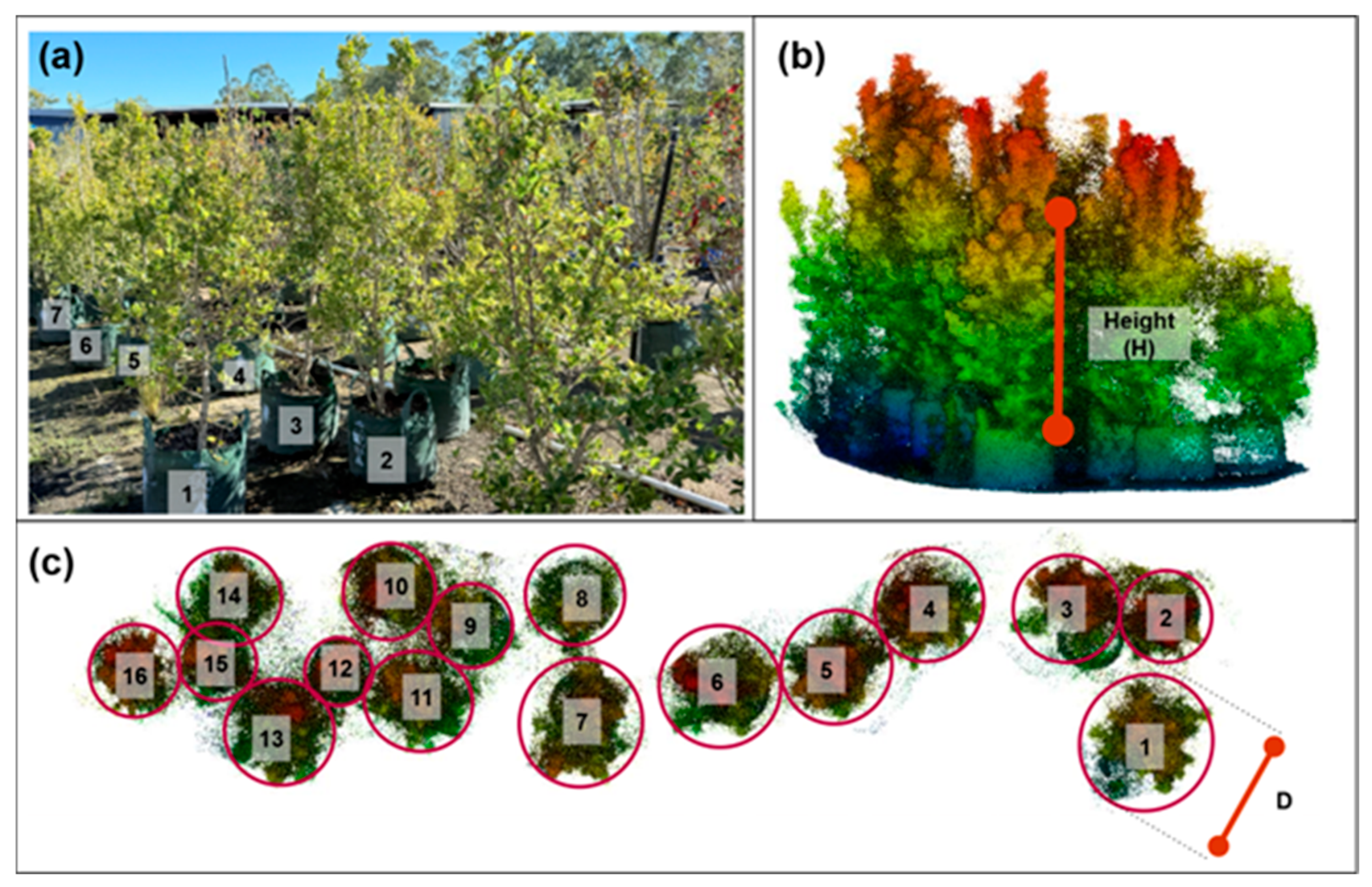
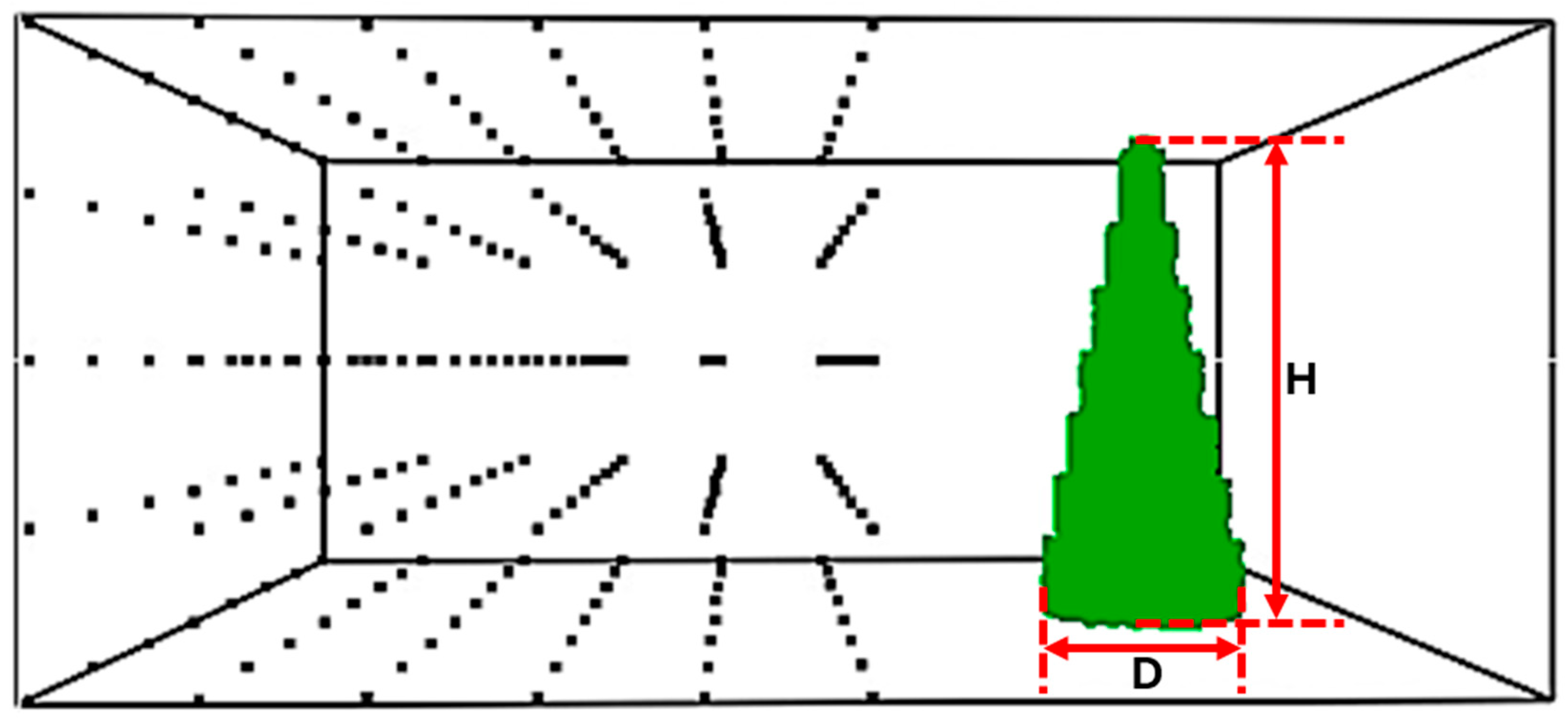
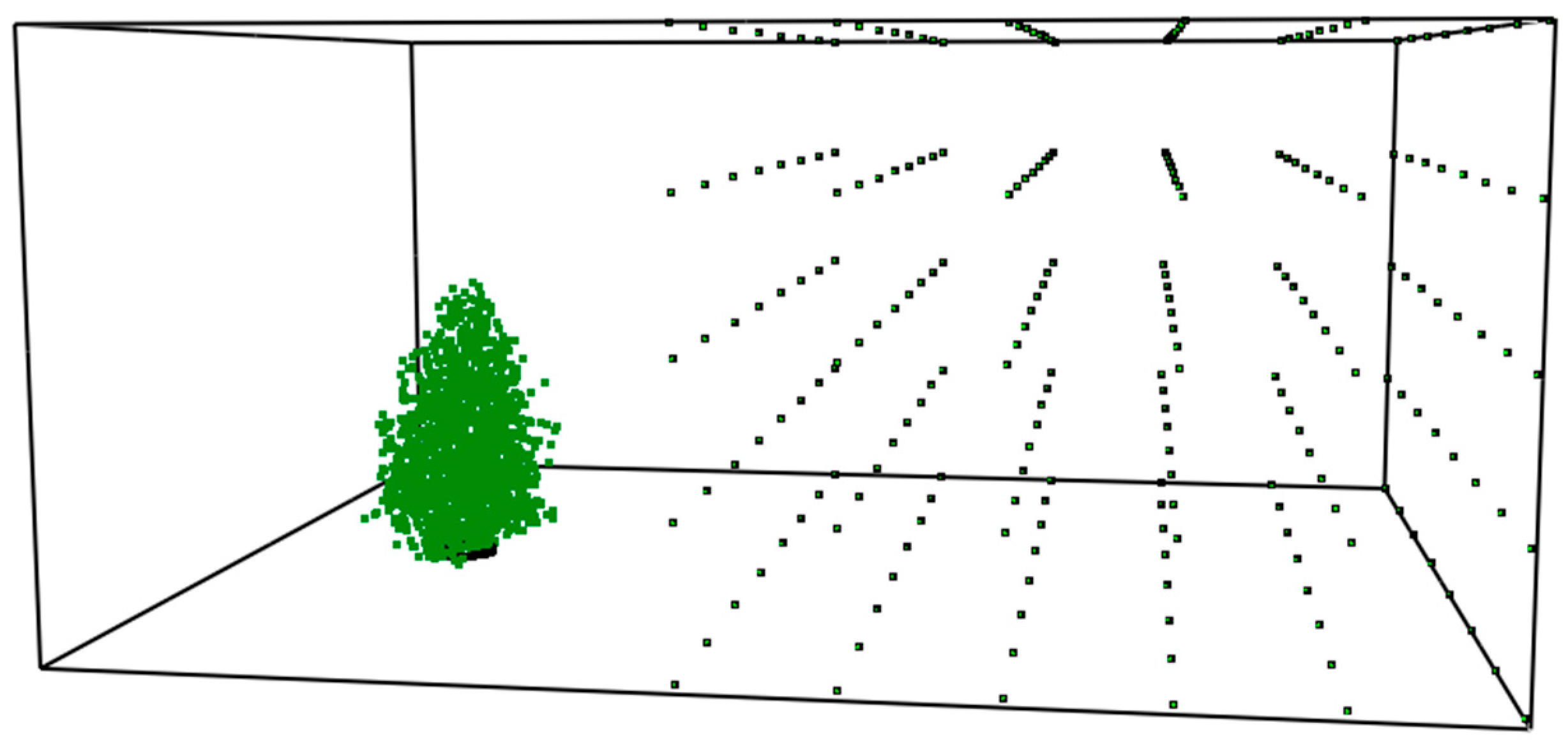
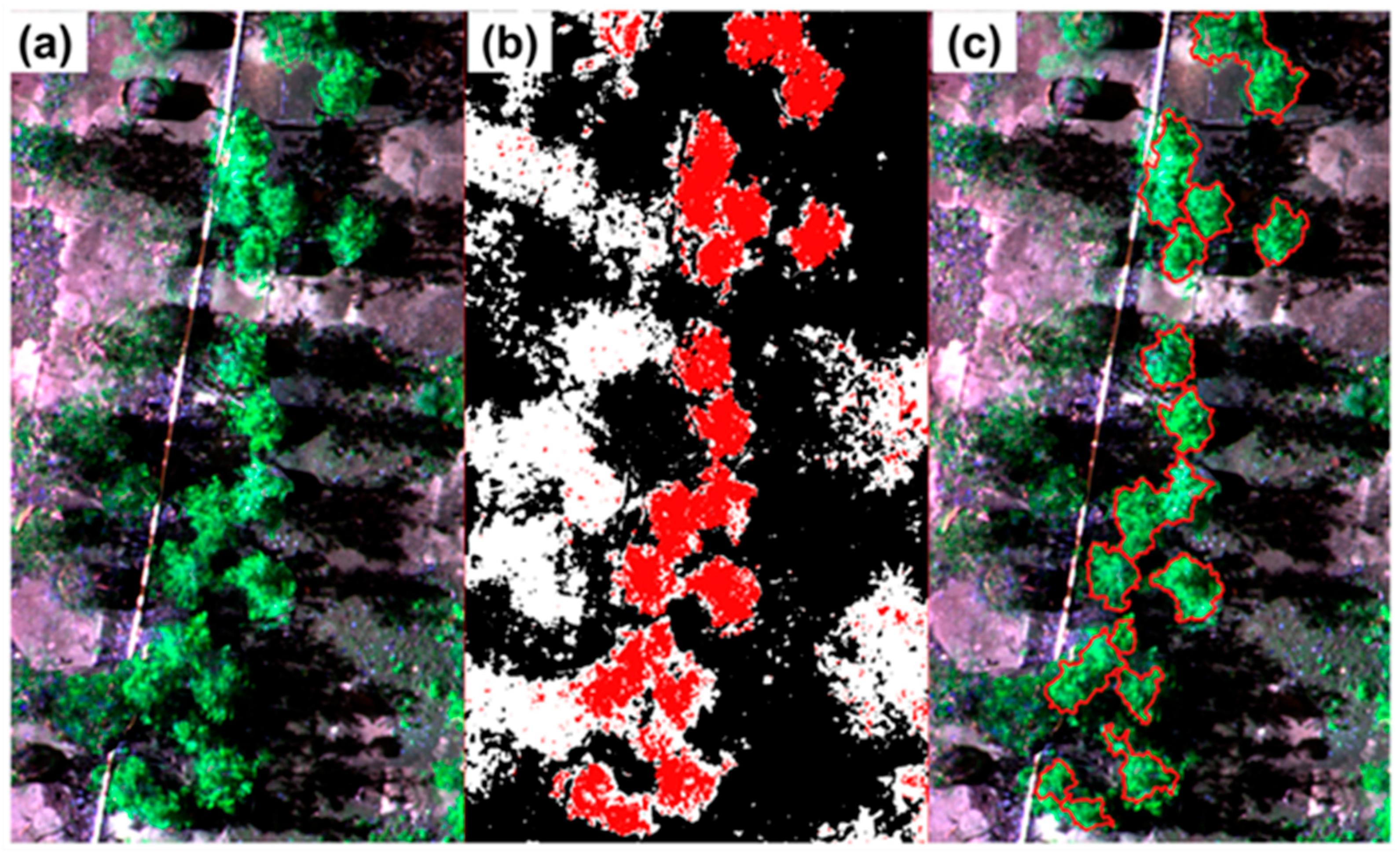
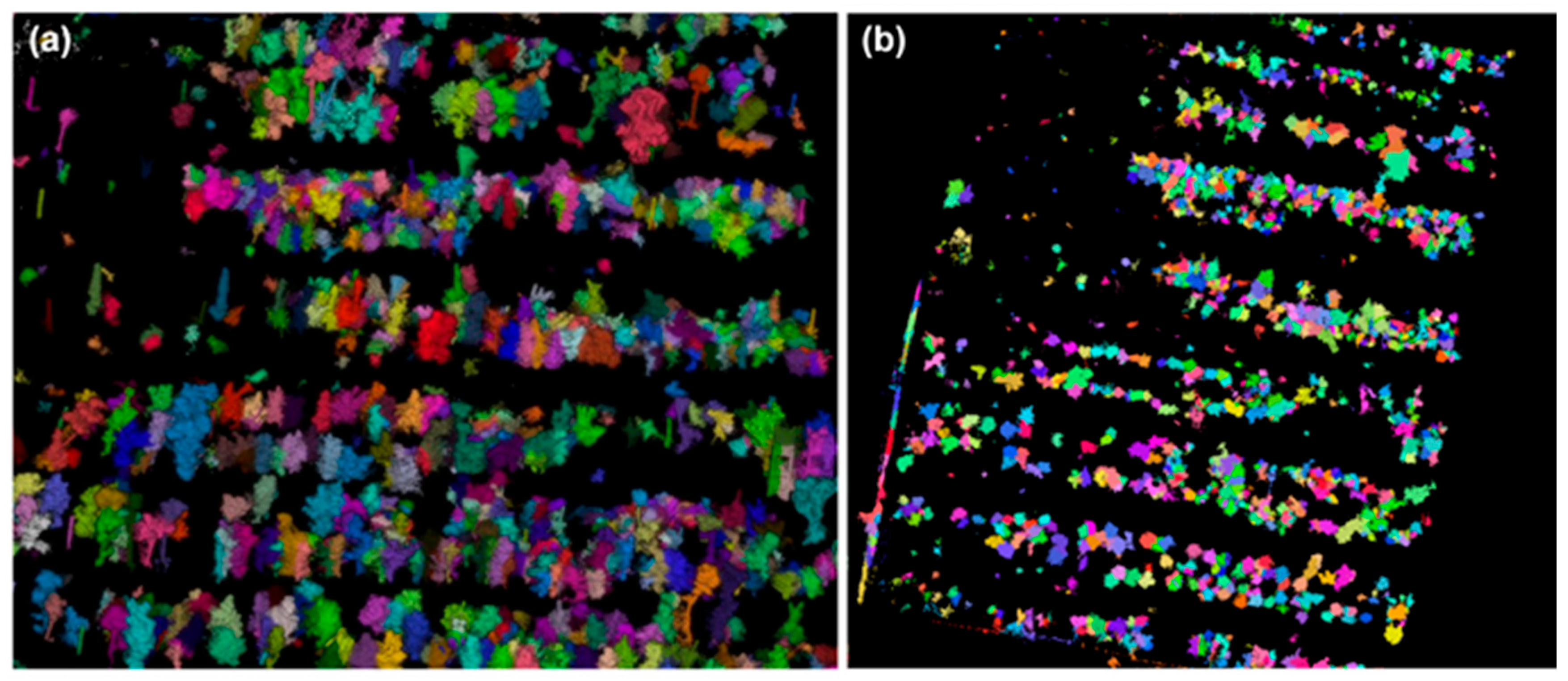
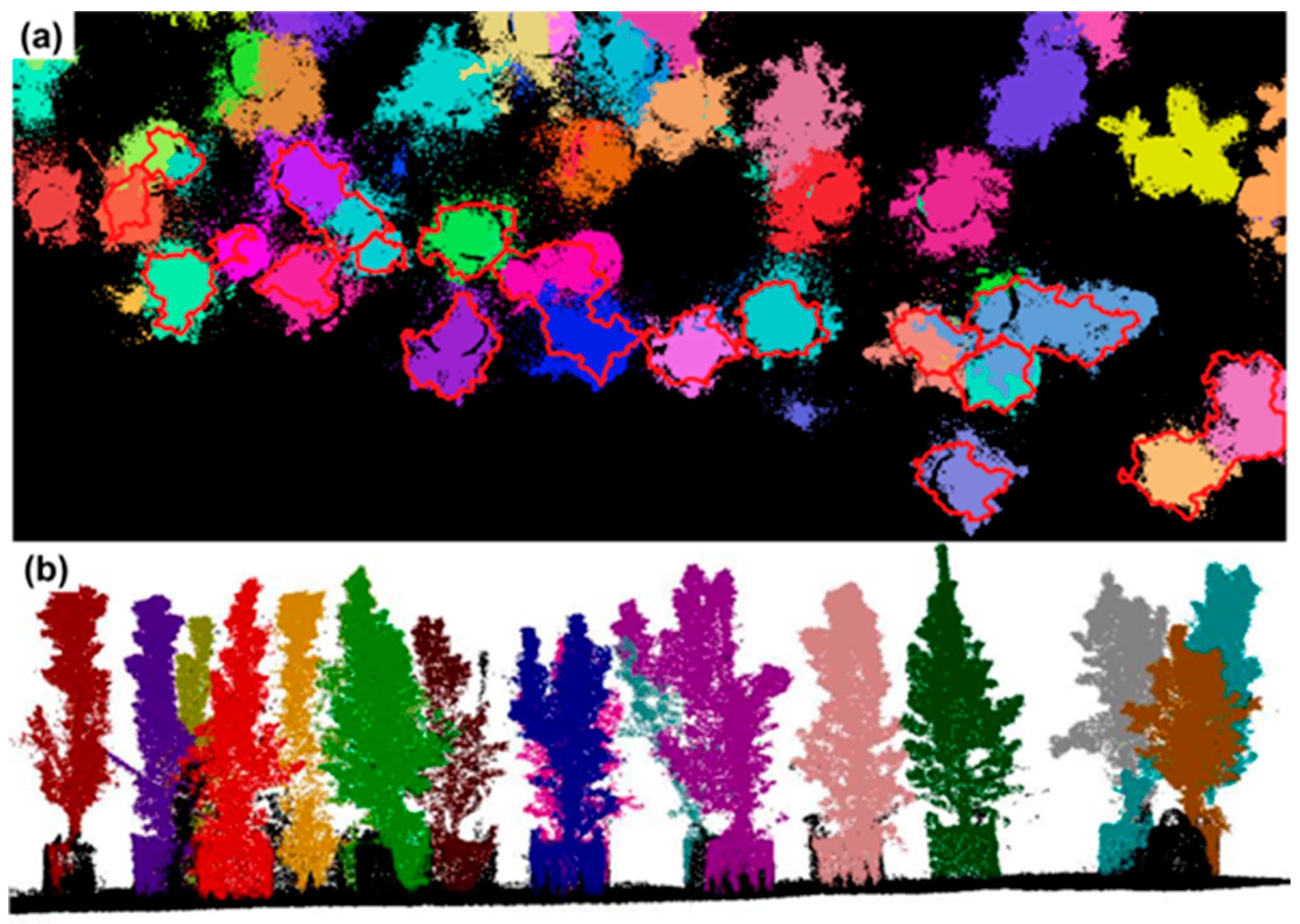
| Predicted/Detected Responses | Models/Simulation Platforms | Primary Focus | Data Acquisition | Place of Study | Remarks | Reference |
|---|---|---|---|---|---|---|
| Radiant heat flux | Physics-based Numerical, WFDS, FDS | Elevated vegetation in WUI | Experimental data and field measurements | USA | Simulates fluid flow, combustion, heat transfer and thermal degradation. | [7] |
| Fire behavior for different fuel conditions | CFD modeling and FDS | WUI | Historical fire data in SE France | France | WUI fire modeling with CFD for different vegetation scenarios (fuel loads) with 3D fire propagation assessment in FDS | [20] |
| Fire spread in grasslands | Physics-based computer simulation, WFDS | Grasslands | WFDS simulation data | Australia | Predicts head fire spread rates and fire perimeter development under varying wind and ignition conditions | [21] |
| Fire spread rate | A generic, empirical-based model | Heathland and shrubland | Experimental data | Australia | Dead fuel moisture content is predicted. The model demonstrates rate-of-spread predictions. | [22] |
| Heat transfer in structures (HF and T) | CDF modeling and FDS | WUI vegetation and building structures | Simulated data (Lagrangian particle models) | Portugal | Governing parameters in burning vegetation in WUI were quantified in FDS. Impacts were assessed on buildings and quantified heat release rates, HF and T | [23] |
| Heat transfer, AGB | Point cloud-based, FDS | Woodland surrounding | UAS–LiDAR | Australia | Geometric features of vegetation components, and foliage incorporated into heat transfer | [24] |
| Heat transfer | CFD modeling and Point cloud-based, FDS | Building structures in bush fire prone areas | UAV-LiDAR | Australia | Point clouds were utilized to construct heat transfer models in FDS, examining wind velocities, temperature profiles, and pressure distributions during bushfire events. | [25] |
| Fuel load | Random Forest model and numerical calculations | Longleaf Pine (crown level) | LiDAR—ALS, TLS | USA | Evaluate the effects of ALS, TLS, and their fusion on crown-level structural and fuel metric modeling. | [26] |
| Wildfire risk assessment | Burn-P3 simulation model, numerical calculations | Wildland | MODIS | Greece | Predicted fire effects were first quantified and mapped using a spatial index, then builds the burn probability, fire intensity to evaluate the fire risk | [27] |
| Wildfire risk mitigation within the WUI | GeoAI simulation | WUI | LANDFIRE 2020, NASA Socioeconomic Data | USA | Incorporates spatial data replicate fire behavior. | [28] |
| Bushfire burn severity | Random Forest, Fuzzy Forest, Boosted Regression Tree, and Extreme Gradient Boosting | Wildland | MODIS, BARRA data | Australia | Burn severity index is derived, calculated from pre-fire and postfire imagery. The variables influencing the burn severity have been evaluated. | [29] |
| Forest fire risk (Forest Fire Danger Index) | RTDS | Wildland | Historical disaster data, MCD64, MODIS, China Surface Climate Daily Data Set | China | The AHP, the entropy method, and minimal relative entropy theory, a CFFRI was developed to evaluate forest fire risk levels. | [30] |
| Channels | Spectral Indices | Equations |
|---|---|---|
| SI1 | NDVI | |
| SI2 | NDWI | |
| SI3 | GCI | |
| SI4 | GLI | |
| SI5 | NDRE |
| Tree ID | H (m) | D (m) |
|---|---|---|
| 1 | 0.89 | 0.594 |
| 2 | 1.20 | 0.443 |
| 3 | 1.18 | 0.555 |
| 4 | 0.97 | 0.604 |
| 5 | 1.21 | 0.445 |
| 6 | 1.36 | 0.618 |
| 7 | 1.13 | 0.574 |
| 8 | 0.92 | 0.473 |
| 9 | 0.91 | 0.422 |
| 10 | 0.91 | 0.467 |
| 11 | 1.15 | 0.479 |
| 12 | 1.28 | 0.298 |
| 13 | 1.34 | 0.543 |
| 14 | 1.14 | 0.453 |
| 15 | 1.20 | 0.310 |
| 16 | 1.34 | 0.446 |
| Hyperparameter | Base | Meta | |||
|---|---|---|---|---|---|
| XGBoost | LightGBM | CatBoost | Random Forest | XGBoost | |
| Number of Estimators/Trees | 700 | 1200 | 9000 | 1200 | 600 |
| Learning Rate | 0.1 | 0.1 | 0.3 | N/A | 0.1 |
| Max Depth/depth | 6 | −1 | 8 | 20 | 6 |
| Column Sampling | 1 | 0.8 | N/A | max_features: ‘sqrt’ | 1 |
| Subsampling/Bagging | 0.7 | 0.8 | N/A | N/A | 0.7 |
| Specific Parameters | N/A | num_leaves: 31 min_data_in_leaf: 10 | l2_leaf_reg: 5 random_strength: 1 | min_samples_split: 2 min_samples_leaf: 1 | N/A |
| Models | Accuracy | Recall | Precision | FI Score | |
|---|---|---|---|---|---|
| Base Models | XGBoost | 0.8248 | 0.8248 0.7700 | 0.8279 0.7189 | 0.8228 0.7435 |
| Random Forest | 0.7469 | 0.7469 0.7283 | 0.7629 0.6224 | 0.7403 0.6712 | |
| CatBoost | 0.8208 | 0.8208 0.7667 | 0.8212 0.7242 | 0.8191 0.7449 | |
| LightGBM | 0.8459 | 0.8459 0.7924 | 0.8490 0.7439 | 0.8444 0.7674 | |
| Meta Model | XGBoost | 0.8451 | 0.8451 0.7898 | 0.8467 0.7387 | 0.8439 0.7634 |
| Species | Pixel Count | Class ID | Precision | Recall | F1 Score | Support |
|---|---|---|---|---|---|---|
| Syzygium smithii (Lilly Pilly) | 64,359 | 0 | 0.7385 | 0.7898 | 0.7634 | 12,872 |
| Callistemon viminalis | 55,428 | 1 | 0.9657 | 0.9788 | 0.9722 | 9086 |
| Viburnum odoratissum | 53,195 | 2 | 0.9360 | 0.9094 | 0.9225 | 4439 |
| Solitaire palm | 51,500 | 3 | 0.9480 | 0.9445 | 0.9463 | 5100 |
| Hibbertia scandens | 49,709 | 4 | 0.9384 | 0.9657 | 0.9518 | 5942 |
| Livistona australis | 47,167 | 5 | 0.9395 | 0.9462 | 0.9428 | 7433 |
| Cuprocyparis leylandii | 44,625 | 6 | 0.7975 | 0.8660 | 0.8304 | 26,845 |
| Macadamia integrifolia | 46,142 | 7 | 0.8973 | 0.7739 | 0.8311 | 3229 |
| Hibiscus rosa-sinensis | 37,674 | 8 | 0.8384 | 0.7221 | 0.7759 | 3534 |
| Other vegetation | 64,359 | 9 | 0.8771 | 0.5874 | 0.7036 | 2528 |
| Non-vegetation | 64,359 | 10 | 0.7964 | 0.7070 | 0.7490 | 14,531 |
Disclaimer/Publisher’s Note: The statements, opinions and data contained in all publications are solely those of the individual author(s) and contributor(s) and not of MDPI and/or the editor(s). MDPI and/or the editor(s) disclaim responsibility for any injury to people or property resulting from any ideas, methods, instructions or products referred to in the content. |
© 2025 by the authors. Licensee MDPI, Basel, Switzerland. This article is an open access article distributed under the terms and conditions of the Creative Commons Attribution (CC BY) license (https://creativecommons.org/licenses/by/4.0/).
Share and Cite
Keerthinathan, P.; Subasinghe, I.K.; Krishnakumar, T.; Ariyanayagam, A.; Hamilton, G.; Gonzalez, F. Prediction of Thermal Response of Burning Outdoor Vegetation Using UAS-Based Remote Sensing and Artificial Intelligence. Remote Sens. 2025, 17, 3454. https://doi.org/10.3390/rs17203454
Keerthinathan P, Subasinghe IK, Krishnakumar T, Ariyanayagam A, Hamilton G, Gonzalez F. Prediction of Thermal Response of Burning Outdoor Vegetation Using UAS-Based Remote Sensing and Artificial Intelligence. Remote Sensing. 2025; 17(20):3454. https://doi.org/10.3390/rs17203454
Chicago/Turabian StyleKeerthinathan, Pirunthan, Imanthi Kalanika Subasinghe, Thanirosan Krishnakumar, Anthony Ariyanayagam, Grant Hamilton, and Felipe Gonzalez. 2025. "Prediction of Thermal Response of Burning Outdoor Vegetation Using UAS-Based Remote Sensing and Artificial Intelligence" Remote Sensing 17, no. 20: 3454. https://doi.org/10.3390/rs17203454
APA StyleKeerthinathan, P., Subasinghe, I. K., Krishnakumar, T., Ariyanayagam, A., Hamilton, G., & Gonzalez, F. (2025). Prediction of Thermal Response of Burning Outdoor Vegetation Using UAS-Based Remote Sensing and Artificial Intelligence. Remote Sensing, 17(20), 3454. https://doi.org/10.3390/rs17203454







